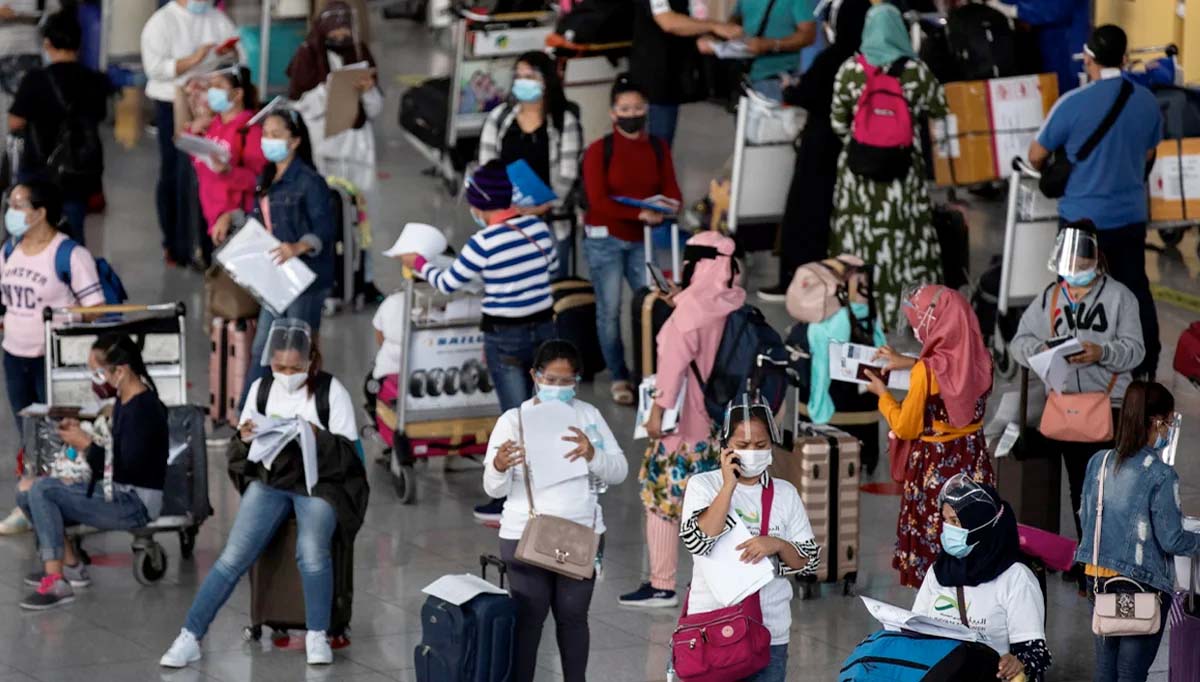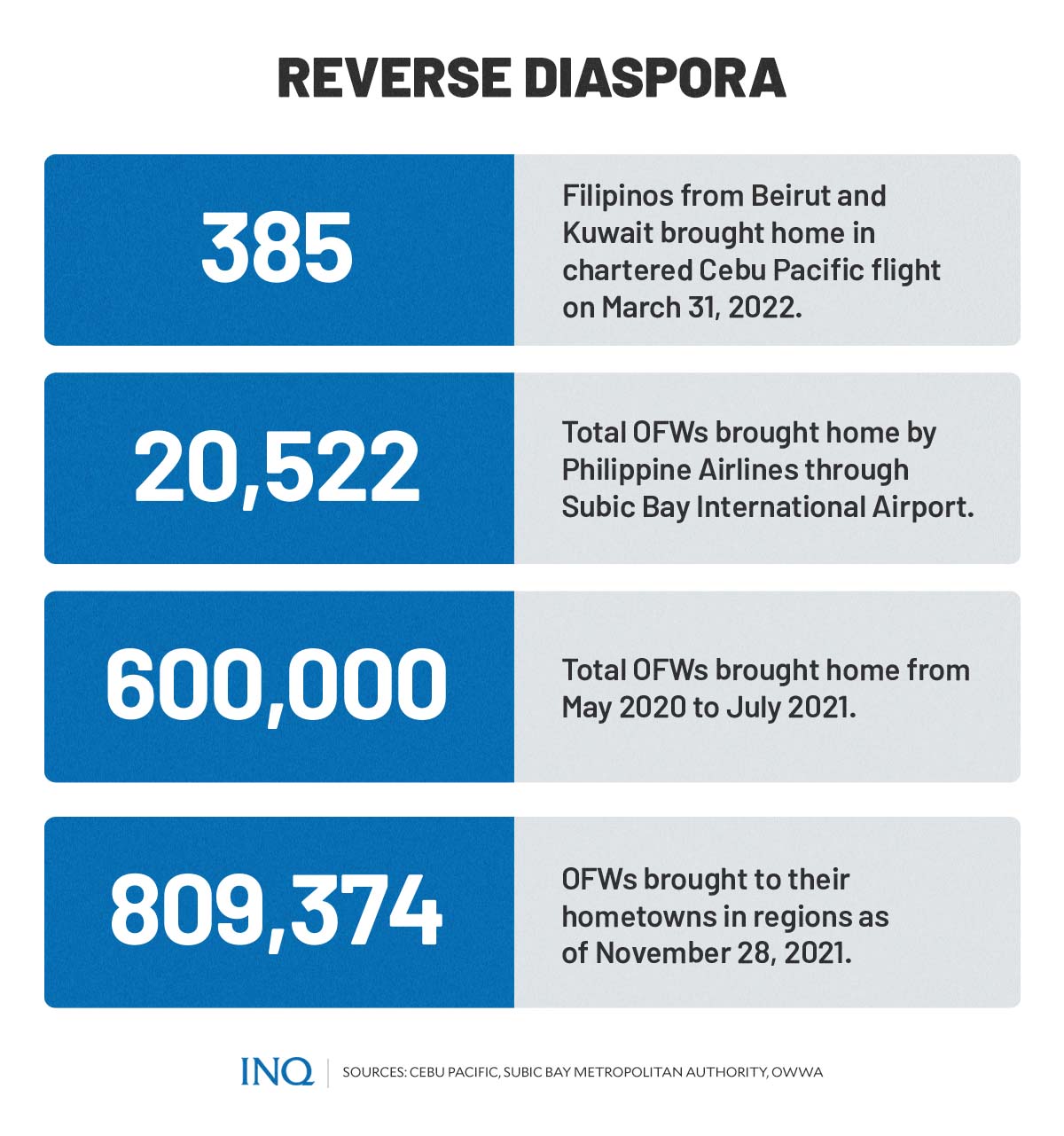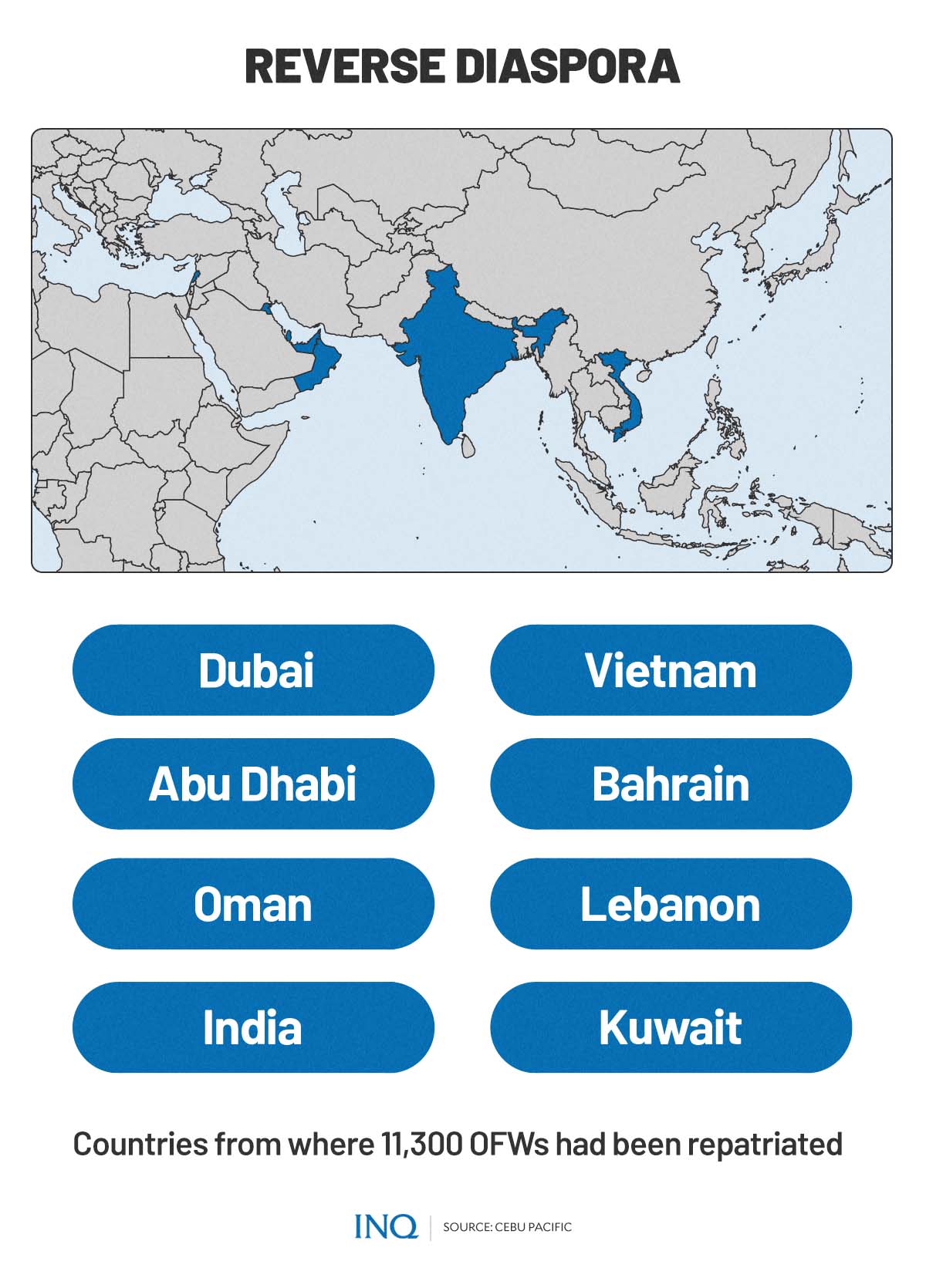Jobs, income concerns persist as more OFWs return to PH for good

FILE PHOTO: Overseas Filipino workers or OFWs wait at the airport.
MANILA, Philippines—As the number of repatriated Overseas Filipino Workers (OFWs) continued to increase, concerns grow about the looming uncertainty that they would face at home—including employment and source of income.
For many decades, OFWs leave their families to try their luck and look for better job opportunities across the globe.
However, the ongoing COVID-19 pandemic—as well as other challenges impacting countries—has led to a reverse diaspora and left many OFWs wondering about what will be their next step to provide for their families as they return home.
Over two years into the pandemic, a key question is still begging to be answered—What will happen now to those already home?
Huge reverse diaspora continues
Last March 31, 385 Filipinos from Beirut and Kuwait were brought home by Cebu Pacific (CEB) via a charter flight arranged by the Department of Foreign Affairs (DFA) to repatriate distressed OFWs.
Article continues after this advertisement“We are happy to support the government in bringing home more kababayans. We are honored to enable them to reunite with their loved ones after such a long time,” said Alex Reyes, chief strategy officer at Cebu Pacific in a statement released on April 4.
Article continues after this advertisement
GRAPHIC: Ed Lustan
According to CEB, it has repatriated over 11,300 Filipinos from Dubai, Abu Dhabi, Oman, India, Vietnam, Bahrain, Lebanon, and Kuwait through Bayanihan and DFA-arranged charter flights since July last year.
The Subic Bay Metropolitan Authority (SBMA) reported last February 23 that a total of 20,522 OFWs and other returning Filipinos have been repatriated by the Philippine Airlines (PAL) through the Subic Bay International Airport (SBIA).

GRAPHIC: Ed Lustan
For nine months, PAL has had 82 repatriation flights. The repatriation flight on February 22, however, was the last.
READ: PAL’s repatriation flights via Subic stop after bringing home 20,522 OFWs
Overseas Workers Welfare Administration (OWWA) Administrator Hans Cacdac said last December that from May 2020 to July 2021, the government has brought home over 600,000 OFWs who lost their jobs amid and due to the ongoing global health pandemic.
As of November 28, OWWA records showed that a total of 809,374 OFWs were transported back to their home regions after undergoing quarantine protocols and receiving assistance from the government.
Most of the repatriates, according to the Department of Labor and Employment (DOLE), are pandemic-affected workers and displaced OFWs affected by lockdowns imposed to curb the spread of COVID-19.
“Many of our OFWs became helpless when the pandemic struck and so the government launched a massive repatriation drive never done before,” Labor Secretary Silvestre Bello III said in a statement.
READ: Repatriated OFWs amid COVID-19 pandemic breach 800,000-mark
Last year, Defense Secretary Delfin Lorenzana gave higher estimates of the reverse diaspora. He said that as of June 28, more than 1 million Filipinos had been repatriated or had returned to the Philippines since the pandemic struck.
As of June 28, Lorenzana said a total of 1,237,186 overseas Filipinos have been repatriated—1,005,885 OFWs and 231,301 Filipino residents of foreign countries. Of the OFWs, 591,956 are land-based and 413,929 are sea-based.
“It’s the biggest repatriation ever in our history, possibly the biggest repatriation anywhere, of any country, in the world,” Foreign Affairs Secretary Teodoro Locsin Jr. said in a Twitter post way back in August 2020. He was not exaggerating.
READ: Repatriation biggest ever in PH history
Elusive employment, income
Uncertainty, however, looms on the horizon for repatriated OFWs as they come home. The biggest question is what jobs are there for them in the Philippines?
Out of the total 8,332 OFWs who arrived in the Philippines during the pandemic by the end of 2020 and have answered the survey conducted by the International Organization for Migration (IOM), 83 percent said they remained unemployed “three months after their return.”
READ: OFW departures pick up, shows need for jobs defies COVID
“This came at a time whereby joblessness in the Philippines hit a record-high of 10.3% for 2020 as a direct result of COVID-19 and the associated lockdowns,” the IOM, a United Nations (UN) agency, said in its report released last year.

GRAPHIC: Ed Lustan
“OFWs stated their biggest need was to obtain employment with over 78 percent of all returnees identifying income generation as their greatest challenge,” it added.
At least 48 percent also said they suffered a 60 percent drop in income after their return to the Philippines. Unfortunately, around 17 percent said they did not receive their salary before returning to the Philippines.
Among those who reported early contract termination, the IOM found that 59 percent were not able to secure separation or compensation pay.
READ: As OFWs come home, bigger risks add to their uncertain future
While for some of the respondents, starting a business in their hometown was an option for a new source of income, IOM noted that the striking element is that only 27 percent reported having capital to start businesses.
At least 69 percent said there’s no means to acquire capital and 4 percent said the money they had was insufficient.
The IOM report said at least 50 percent of those who said they have no capital would not know how to obtain seed money with more women OFWs saying this.
Supporting distressed, repatriated OFWs
In a statement last year, Susan Ople, former labor undersecretary and president of the Blas F. Ople Center, listed some of the accomplishments achieved by the Ople Center through its partnership with and Inter-Agency Council Against Trafficking (IACAT) during the Duterte administration, including:
- Livelihood training for 596 exploited domestic workers mostly from the Middle East who have transitioned from exploitation to entrepreneurship.
- With help from business partners, such as San Miguel Corporation, some of the 581 domestic workers who graduated from the livelihood courses were able to start their own businesses.
READ: As OFWs come home, bigger risks add to their uncertain future
Sen. Joel Villanueva has recently urged the government to craft a national strategy that would tap the talent pool of OFWs who have returned to their families for good.
“This is the brain gain we should be exploiting. There is a social dividend waiting to be earned from this reverse diaspora,” said Villanueva in a statement last March 13.
“I view their return as an enhancement of our labor pool. They’re bringing with them skills they have acquired abroad. Our society must benefit from their experience, and government must show the way,” he added, noting that manpower and mentorship—like in construction—are necessary for post-COVID economic recovery.
READ: Villanueva to gov’t: Tap talent pool of repatriated OFWs
Last year, Villanueva suggested the conduct of a general and unified inventory of the skills of repatriated OFWs which can be used to match OFWs with available jobs suitable for them.
Government agencies already have existing programs which likewise aim to help repatriated OFWs.
The OWWA, according to its website, offers different types of reintegration programs as “a way of mainstreaming returning OFWs into Philippine society.”
The DOLE also offers a psycho-social program as part of its reintegration services, which consists of “capacity-building through assistance in community organizing and maintaining OFW Family Circles (OFCs), and services like psycho-social counseling, stress debriefing, values formation, and financial literacy.”
According to a report submitted by the Philippines to voluntarily comply with the Global Compact for Safe, Orderly and Regular Migration (GCM) review of the United Nations Economic and Social Commission for Asia and the Pacific, the government has integrated mechanisms to synchronize and streamline repatriation and integration of OFWs.
One of these was the Comprehensive OFW Reintegration Program (CORP), a flagship program of OWWA, and the National Reintegration Center For OFWs (NCRO).
The UN review said the program was meant to “strengthen and harmonize the reintegration programs and services provided by various stakeholders.”
Several job offers are also being made available for returning OFWs. These include the entry-level teaching positions at the Department of Education (DepEd) through a program called “Sa Pinas Ikaw ang Ma’am, Sir.”
The “Agri-Negosyo Para sa OFWs” by the Department of Agriculture (DA, Technical Education and Skills Development Authority (TESDA), Department of Trade and Industry (DTI), and two other government agencies, also aims to help repatriated OFWs venture into agribusiness.
Free skills training programs, such as “Tesda Abot Lahat ang OFWS,” are also being offered to open more job opportunities for repatriated OFWs.
On top of these, OWWA also offers financial and livelihood support programs for OFWs.
READ: OFWs are back home, what now?
RELATED STORIES:
High expectation on DMW: More convictions for human traffickers
National action plan emerging vs illegal recruitment
Illegal recruiters know no pandemic, continue to prey on OFWs
OFW departures pick up, shows need for jobs defies COVID
TSB
For more news about the novel coronavirus click here.
What you need to know about Coronavirus.
For more information on COVID-19, call the DOH Hotline: (02) 86517800 local 1149/1150.
The Inquirer Foundation supports our healthcare frontliners and is still accepting cash donations to be deposited at Banco de Oro (BDO) current account #007960018860 or donate through PayMaya using this link.















